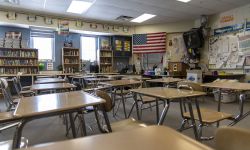What school restart deal means for Michigan parents, students and educators

LANSING — With most school restart dates just weeks away, the Michigan Senate on Saturday approved a “return to learn” plan agreed to late Friday by legislative leaders and Gov. Gretchen Whitmer.
The legislation finalizes guidelines for statewide school districts already planning to restart using either online-only, in-person or blended instruction. But the deal provides little funding certainty for districts bracing for possible cuts because of the state’s projected budget deficit.
Some superintendents and administrators objected to the last-minute legislation, arguing it would create more busywork — and potentially subject them to parental scorn — as they grapple with the challenges of educating students in the middle of a global pandemic.
- Michigan coronavirus unemployment, map, curve, COVID-19 updates
- Dashboard: Michigan coronavirus testing numbers, trends, COVID-19 data
- Whitmer, GOP reach Michigan school restart deal over protests from educators
- Audit slams Michigan oversight of remote learning as districts embrace it
- Michigan school reopening tracker: Find out if your district is starting in person or online
But supporters say the deal between Whitmer and legislative leaders gives schools flexibility to make their own instruction plans while implementing new accountability measures to ensure students are taught effectively and parents have the opportunity to voice concerns.
Teachers' unions came out in support of the legislation Saturday morning, saying that while it is not perfect, it provides “students, parents, educators and districts both certainty and flexibility on key issues as we head into the 2020-21 school year.’
Here’s what parents, students and educators need to know about the three-bill package, which the Michigan House is expected to approve Monday and send to Whitmer’s desk for signature.
Schools can start online or in-person — but must reassess monthly
The bipartisan deal does not require districts to offer in-person classes, which House Republicans had sought to mandate as an option for younger students in grades K-5.
Instead, schools can choose the instruction model of their choice — in-person, online-only or a combination — a decision they were already required to make by this weekend under a previous executive order from Whitmer.
Many districts have already made the decision to begin the school year with online-only instruction, including Grand Rapids, Bloomfield Hills and Lansing.
But the new deal requires districts to submit another “extended COVID-19 learning plan” by October, which must be developed in consultation with staff and the local health department. The local plan must be published on the district website and then reevaluated monthly throughout the school year.
Parents can apply pressure
School boards would also need to vote on those instruction and student safety plans every month in public meetings, which supporters say ensures parents have “the opportunity to voice their concerns and keep the community informed of needed adaptations.”
But school officials fear those “reconfirmation” meetings could devolve into public shouting matches given heightened tensions over the ongoing pandemic, masks and other public safety measures.
“Why ANYONE would sign-on to legislation that purposefully creates monthly overly-politicized and heated school board meetings is a question I cannot answer,” Bob McCann, executive director of the Tri-County Alliance for Public Education superintendents group, wrote on Twitter.
“Because they can say ‘local control’ and not own any of the challenges of reopening,” Detroit Superintendent Nikolai Vitti responded. “Abandoning leadership responsibilities when needed most.”
Individual student-teacher interactions required
All sides agree that in-person instruction would provide the best outcome for children who fell behind when school was cancelled because of the pandemic in the spring, but there is disagreement on whether that could be done in a way that protects students and teachers from COVID-19.
The compromise between Whitmer and legislative leaders allows districts to choose online-only instruction but imposes new accountability measures on those that do.
Chief among them: Schools must document “two-way interactions” between teachers and students to ensure individualized instruction during remote learning. Under the legislation, district’s must require two personal interactions between a student and his or her teacher each week, for at least 75 percent of all enrolled students, and publish interaction rates online.
The legislation gives schools new flexibility to conduct classes online by waiving traditional requirements that they educate students 180 days and 1,098 hours per year, which administrators feared would be difficult to track in a virtual setting. Instead, they’ll have to document how they intend to deliver an equivalent level of instruction this year.
Students testing continues
Michigan is seeking federal waivers to skip standardized tests this year, but the legislation requires all students to take “benchmark assessments” in the fall (within the first nine weeks of the academic year) and spring to gauge their academic achievement levels.
The Michigan Department of Education must approve at least four testing options and provide districts with one of those tests at no cost. What’s not clear from the legislation is how districts would administer those tests, which are traditionally conducted in person.
Under the bills, districts must send “aggregate” data to the state by June 30, but the test results this year cannot be used to grade schools under Michigan’s new school accountability system.
The goal, according to a legislative intent statement, is that the test data be “primarily utilized to determine the loss of learning, if any, resulting from the COVID-19 pandemic.”
Masks recommended, sometimes required
The legislation does not impose new public safety rules on school districts, but local officials must routinely evaluate measures they were already required to include those in the “COVID-19 preparedness” plans that Whitmer ordered them to complete by Friday.
Under the governor’s June 30 order, in most parts of the state schools that offer in-person instruction must require students and staff to wear masks on school buses, in hallways and common areas. Whitmer is encouraging districts to require students of all ages to wear masks in the classroom, but she is only requiring it for students in grades 6-12.
Those mask rules don’t apply to the Upper Peninsula and northern Michigan, which are already in Phase 5 of Whitmer’s economic restart plan. Under her executive order, schools in the rest of the state must also prohibit indoor assemblies and outline other safety precautions, including health screenings, testing protocols and extra cleaning regimens.
New counts for students to minimize impact of transfers
Education officials expect a flood of student transfers this fall as parents seek districts that offer their preferred method of instruction, whether that be in-person, online or a combination.
That could have major budget implications because Michigan gives a set amount of funding to each district based on the number of students enrolled each year.
The plan negotiated by Whitmer and GOP legislators seeks to minimize the budgetary impact of that "churn" by creating a new student count formula for the 2020-21 school year. How much per-pupil funding districts receive remains an open question given the state’s projected budget deficit, but it would be distributed this year based on a combination of last year’s pupil count (weighted at 75 percent) and a new fall pupil count (weighted at 25 percent).
That would provide stability to districts that see a significant number of students depart, but it also means districts won’t be fully rewarded for incoming transfers even if they are providing an instructional model that parents prefer.
School administrators wanted student counts to be based on last year’s enrollment and are wary of what would be a complicated method for counting students this year under the new deal.
To qualify as an enrolled pupil for funding purposes, a student must log-in or attend a virtual class, complete an assignment, complete a course lesson or complete an offline assignment on the pupil count day. That student must also have at least one two-way interaction with a teacher on that count day and each of the next three weeks.
Editor's Note: This story was updated Saturday, Aug. 15, to clarify that the governor's executive orders requiring masks in school buses and common areas don't apply to the Upper Peninsula and northern Michigan.
Michigan Education Watch
Michigan Education Watch is made possible by generous financial support from:
Subscribe to Michigan Education Watch
See what new members are saying about why they donated to Bridge Michigan:
- “In order for this information to be accurate and unbiased it must be underwritten by its readers, not by special interests.” - Larry S.
- “Not many other media sources report on the topics Bridge does.” - Susan B.
- “Your journalism is outstanding and rare these days.” - Mark S.
If you want to ensure the future of nonpartisan, nonprofit Michigan journalism, please become a member today. You, too, will be asked why you donated and maybe we'll feature your quote next time!





